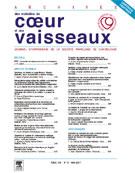01-10 - ADDITIONAL VALUE OF 3-DIMENSIONAL ECHOCARDIOGRAPHIC DYSSYNCHRONY TO CONVENTIONAL 2-DIMENSIONAL DYSSYNCHRONY IN PREDICTING THE RESPONSE AFTER CARDIAC RESYNCHRONIZATION THERAPY - 09/04/08
Antoine Deplagne [1],
Pierre Bordachar [2],
Stephane Lafitte [2],
Patricia Reant [2],
Julien Laborderie [2],
Jacques Clementy [2]
Voir les affiliationsIntroduction: Real-time-3-dimensional (3D) echocardiography has shown great promise for imaging ventricular dyssynchrony (VD). We investigated whether the additional 3D morphologic assessment of VD has any significant impact on the response after cardiac resynchronization therapy (CRT).
Methods: 41 patients with a QRS > 120 ms, class III or IV NYHA and an ejection fraction < 35 % were implanted with a CRT device and underwent a 2D (time dispersion of 12 electromechanical delays) and 3D ecocardiographic assessment of VD (dispersion of time to minimum regional volume for 16 left ventricular segments) 1) before implantation 2) 3 days after implantation with optimization of the pacing interventricular delay with a pre-excitation of the right or left ventricular pacing lead of 20, 40, 60 ms. The changes of 2D and 3D dyssynchrony were correlated with those of cardiac output and ejection fraction 3) 6 months after implantation
Results: 1) During the different configurations of sequential CRT, the changes in 3D VD were highly correlated with those of cardiac output (r = -0.67, p < 0.001) and ejection fraction (r = -0.68, p < 0.001). The correlation between 2D VD and cardiac output and ejection fraction were significant but less (r = -0.60 and r = -0.56 respectively ; p < 0.01). 2) After 6 month of CRT, 76 % of the patients were considered as responders (10 % decrease in end-systolic volume). Before implantation, we observed a significant difference between responders and non responders in terms of 3D VD (p < 0.05) but not in terms of 2D VD (p = ns).
Conclusion: This prospective echocardiographic study demonstrated an additional value of 3D assessment of ventricular dyssynchrony in predicting the response after cardiac resynchronization therapy and in optimizing the pacing configuration.
Plan
© 2007 Elsevier Masson SAS. Tous droits réservés.
Vol 100 - N° 12
P. 1072-1073 - décembre 2007 Retour au numéroBienvenue sur EM-consulte, la référence des professionnels de santé.

